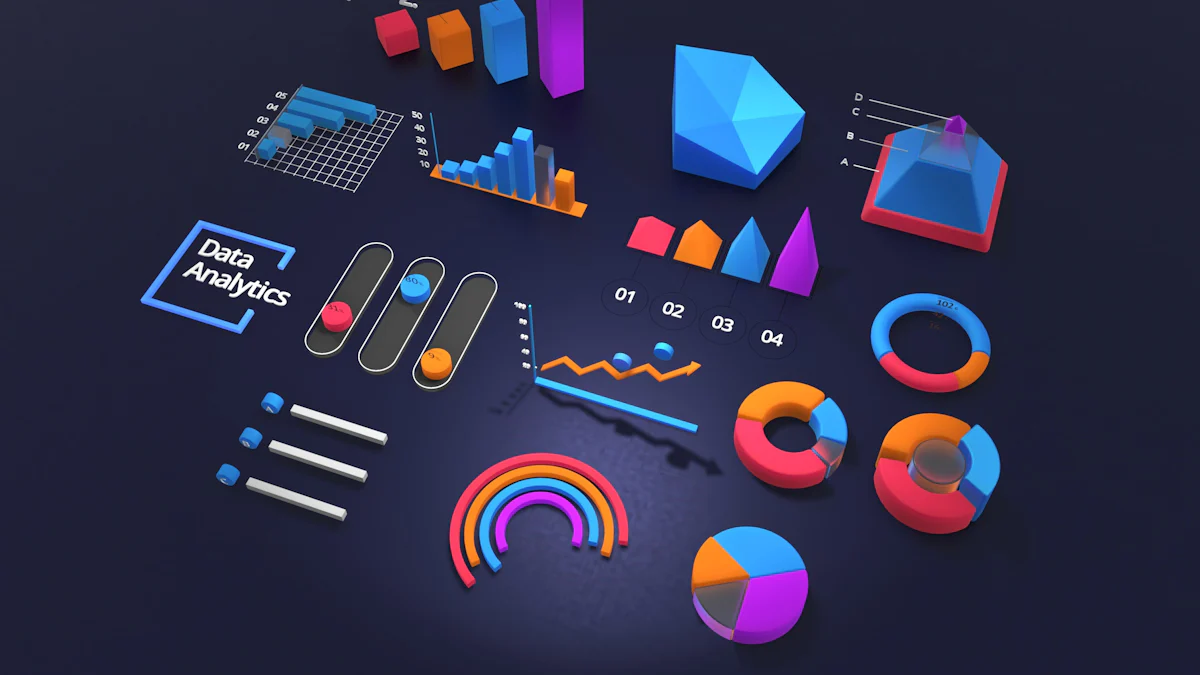How Near-Real-Time Data Replication Transforms Customer Experiences

Retailers today face the challenge of meeting customer expectations in an ever-changing market. Near-real-time data replication equips you with the tools to adapt quickly. It enables you to respond to shifting demand and purchasing trends with precision. For example:
Real-time data helps you track customer behavior, allowing you to tailor marketing campaigns effectively.
Instant payment updates streamline order processing and shipping, ensuring faster service.
This technology empowers you to make smarter decisions, deliver personalized offers, and stay ahead in a competitive landscape.
Key Takeaways
Near-real-time data replication allows retailers to respond swiftly to changing customer demands, enhancing operational efficiency and customer satisfaction.
By providing immediate access to accurate inventory data, businesses can prevent stockouts and overstocking, ensuring products are available when customers need them.
This technology enables personalized shopping experiences through real-time recommendations and targeted promotions, increasing customer engagement and loyalty.
Seamless data consistency across online and in-store channels creates a unified customer experience, reducing frustration and building trust.
Implementing near-real-time data replication can start small, focusing on one area like inventory management, before expanding to other operations for maximum impact.
What is Near-Real-Time Data Replication?
Definition and Key Features
Near-Real-Time Data Replication refers to the process of synchronizing data across systems almost instantly. This ensures that the most up-to-date information is available wherever it is needed. It is a critical tool for businesses that rely on accurate, real-time data to make decisions.
Key features of this technology include:
Immediate Data Consistency: It ensures uniformity in data across systems, which is essential for applications requiring instant accuracy.
Enhanced Data Availability: It provides immediate access to data from multiple locations, reducing downtime and preventing data loss during disruptions.
Robust Disaster Recovery: It offers instant failover capabilities, allowing you to recover quickly from system failures.
Global Data Accessibility: It enables efficient data distribution across different regions, improving performance and user experiences.
These features make it a powerful solution for businesses operating in fast-paced environments.
How It Differs from Traditional Data Replication
Traditional data replication often relies on batch processes, which delay updates and fail to provide immediate consistency. In contrast, near-real-time data replication ensures continuous synchronization across systems. This reduces latency and improves data quality.
For example, traditional methods may update data at scheduled intervals, creating gaps in accuracy. Near-real-time replication eliminates these gaps by keeping data consistent and up-to-date at all times. This makes it ideal for applications where even minor delays can impact performance.
Importance in the Retail Industry
In retail, near-real-time data replication plays a vital role in enhancing operations and customer experiences. It allows you to replicate customer data from various sources, helping you understand spending patterns and behavior. This unified view enables you to deliver personalized offers and discounts in real time.
Retailers also benefit from real-time insights into inventory needs and supply chain management. You can predict demand, optimize stock levels, and respond to purchasing trends quickly. Additionally, instantaneous updates on payments help you process and ship orders faster.
By leveraging this technology, you can improve marketing campaigns, streamline operations, and meet customer expectations more effectively.
Enhancing Retail Operations with Near-Real-Time Data Replication

Inventory Management
Accurate Inventory Tracking
Accurate inventory tracking is essential for smooth retail operations. Near-real-time data replication ensures you always have the latest information about stock levels. This technology provides timely notifications when inventory runs low, enabling you to restock quickly. It also helps you monitor deadlines, ensuring products are available when needed. Additionally, you can respond to changing customer demands by adjusting inventory levels in real time.
Example of Benefit | Description |
|---|---|
Timely Notifications | Real-time data can send alerts when stock levels are low, enabling quick restocking decisions. |
Monitoring Deadlines | It helps track whether product deadlines are met, ensuring timely inventory management. |
Responding to Demand | Businesses can adjust inventory based on changing customer purchasing patterns, enhancing responsiveness to market trends. |
Preventing Stockouts and Overstocking
Stockouts and overstocking can disrupt your business and impact customer satisfaction. Near-real-time data replication helps you predict inventory needs accurately. It optimizes supply chains, ensuring products are available when customers need them. By using real-time data, you can create forecasting models to anticipate demand and manage stock efficiently. This approach reduces waste and improves distribution.
Predict inventory needs with real-time data.
Optimize supply chains to prevent stockouts.
Use forecasting models to anticipate demand.
Achieve efficient distribution through better stock management.
Supply Chain Optimization
Improved Supply Chain Visibility
Transparency in the supply chain is critical for identifying bottlenecks and reducing risks. Near-real-time data replication enhances visibility by providing up-to-date information. You can respond faster to critical situations and adapt to variable market conditions. This technology also accelerates financial reporting, helping you make informed decisions.
Gain transparency into supply chain bottlenecks.
Respond quickly to critical situations.
Accelerate financial reporting.
Reduce risks in changing market conditions.
Faster Responsiveness to Changes
Many manufacturers struggle with visibility and agility in their supply chains. Near-real-time data replication addresses this issue by providing immediate access to updated information. You can react swiftly to changes and collaborate effectively with suppliers and customers. This agility ensures your supply chain remains efficient and adaptable.
Operational Efficiency
Reducing Delays in Decision-Making
Delays in decision-making can slow down your operations. Near-real-time data replication eliminates these delays by providing instant updates. You can respond to changing customer demands and trends without hesitation. For example, real-time payment updates allow you to process and ship orders immediately. This efficiency improves customer satisfaction and keeps your business competitive.
Respond to changing customer demands quickly.
Process and ship orders with real-time payment updates.
Use analytics to optimize marketing campaigns and promotions.
Streamlining Retail Processes
Streamlined processes are vital for operational success. Near-real-time data replication ensures all systems work with the same accurate data. This synchronization reduces errors and improves workflow efficiency. By automating data updates, you can focus on delivering better services to your customers.
Transforming Customer Experience with Near-Real-Time Data Replication
Personalized Shopping
Real-Time Recommendations
Near-real-time data replication allows you to offer real-time recommendations to your customers. By analyzing their browsing and purchasing behaviors instantly, you can suggest products that match their interests. This immediate feedback loop enhances the shopping experience, making it more engaging and personalized. Customers feel understood and valued when they receive suggestions that align with their preferences.
Targeted Promotions
With near-real-time data replication, you can deliver targeted promotions to your customers. By accessing up-to-date data, you can identify trends and tailor offers to specific customer segments. This approach increases the effectiveness of your marketing campaigns and boosts customer satisfaction. When customers receive relevant promotions, they are more likely to engage with your brand and make purchases.
Seamless Omnichannel Experience
Consistency Across Online and In-Store Channels
Real-time data replication ensures data consistency across all platforms, which is crucial for a seamless omnichannel experience. Immediate data consistency and uniformity across distributed systems enhance applications like transactional payment systems and CRMs. This synchronization reduces latency and improves data quality, ensuring that customers have a consistent experience whether they shop online or in-store.
Unified Customer Data for Better Service
Unified customer data enhances service consistency across channels. It allows you to collect valuable data throughout the customer journey, ensuring a consistent shopping experience. Fragmented data can lead to inconsistencies, such as mismatched product recommendations and varying prices, which frustrate customers. Integrating inventory systems across channels provides real-time stock visibility, enabling customers to check product availability online before visiting a store.
Faster Issue Resolution
Up-to-Date Information for Customer Support
Near-real-time data replication provides your customer support teams with up-to-date information. This capability allows them to respond quickly to customer inquiries and issues. Access to the latest data enables support teams to offer accurate solutions, improving customer satisfaction. When customers receive timely assistance, they feel valued and are more likely to remain loyal to your brand.
Proactive Problem-Solving
Proactive problem-solving becomes possible with near-real-time data replication. Customer support teams can detect issues early and provide timely solutions. Nigel Williams from LexisNexis highlights the benefits of sub-10-second synchronization, which allows organizations to deliver information promptly. This proactive approach enhances customer satisfaction by addressing problems before they escalate.
Real-World Examples of Near-Real-Time Data Replication in Retail

Walmart: Optimizing Inventory Management
Walmart has revolutionized inventory management by leveraging near-real-time data replication. This approach ensures accurate stock replenishment across its vast network. Walmart uses Apache Kafka to process tens of billions of messages daily from nearly 100 million SKUs. This system generates precise order plans, enabling timely restocking and reducing the risk of stockouts.
Real-time data replication also enhances collaboration among Walmart's teams. Each team gains controlled access to replenishment plans, improving efficiency and decision-making. By maintaining up-to-date inventory data, Walmart ensures that products are always available when customers need them. This strategy not only streamlines operations but also boosts customer satisfaction.
Target: Ensuring Omnichannel Consistency
Target has embraced near-real-time data replication to deliver a seamless omnichannel experience. This technology synchronizes data across online and in-store platforms, ensuring consistency in product availability, pricing, and promotions. Customers can check stock levels online before visiting a store, reducing frustration and enhancing convenience.
Unified customer data also allows Target to provide personalized service. For example, a customer who starts shopping online can complete their purchase in-store without any discrepancies. This level of integration strengthens customer trust and loyalty. By prioritizing data consistency, Target creates a cohesive shopping experience that meets modern consumer expectations.
Amazon: Delivering Personalized Customer Engagement
Amazon uses near-real-time data replication to offer highly personalized shopping experiences. With Amazon MSK, the company processes user behavior data in real time. This enables instant recommendations tailored to individual preferences. For example, Amazon Personalize analyzes viewing habits and generates suggestions immediately, increasing engagement and satisfaction.
Real-time data integration also ensures that recommendations reflect the latest user interactions. This approach has led to higher subscription rates and increased ad revenue. By combining historical and transactional data, Amazon delivers timely credit offers and other personalized services. These innovations demonstrate how near-real-time data replication enhances customer engagement and drives business success.
Near-real-time data replication has transformed retail by enhancing responsiveness to market changes and improving customer personalization. It empowers you to deliver real-time offer alerts based on transaction records, boosting sales and customer satisfaction. Operational efficiency also increases as you streamline processes and adapt to trends instantly.
Advancements in technology will further amplify its potential. Aggregating data from sources like social media and transaction history will provide deeper insights into spending patterns. This will enable you to refine inventory predictions and create tailored offers. The future of retail lies in leveraging this technology to stay ahead of evolving customer expectations.
Tapdata: Empowering Seamless Data Replication
Tapdata helps organizations replicate data from various sources to data warehouses in near real-time. By ensuring timely and accurate data synchronization, Tapdata enables retail businesses to make informed decisions, improve operational efficiency, and enhance customer experiences. Whether dealing with multiple databases, cloud platforms, or diverse data sources, Tapdata streamlines data migration and replication to support a robust, real-time data ecosystem.
FAQ
What is the difference between real-time and near-real-time data replication?
Real-time replication updates data instantly without delay. Near-real-time replication updates data with minimal delay, often within seconds. This slight delay makes it more cost-effective while still providing timely updates for most business needs.
How does near-real-time data replication improve customer satisfaction?
It ensures accurate, up-to-date information across systems. Customers experience faster service, personalized recommendations, and consistent shopping experiences. These benefits enhance trust and loyalty to your brand.
Is near-real-time data replication difficult to implement?
Modern tools simplify implementation. Platforms like Apache Kafka or Amazon MSK streamline the process. With proper planning and support, you can integrate it into your systems efficiently.
Can small retailers benefit from near-real-time data replication?
Yes! Small retailers can use it to track inventory, personalize customer interactions, and improve operational efficiency. It helps them compete with larger businesses by offering better service and faster responses.
What industries, besides retail, use near-real-time data replication?
Industries like finance, healthcare, and logistics rely on it. Banks use it for fraud detection. Hospitals ensure accurate patient records. Logistics companies track shipments in real time.
💡 Tip: Start small when implementing near-real-time data replication. Focus on one area, like inventory management, before expanding to other operations.
See Also
The Impact of Real-Time Data on AI Choices
Facilitating Instant Data Exchange Across Different Platforms
Exploring Data Integration Strategies to Boost Business Success
The Role of Customer 360 in Shaping Business Plans
Utilizing TapData for Enhanced Real-Time Efficiency in Smart Factories

